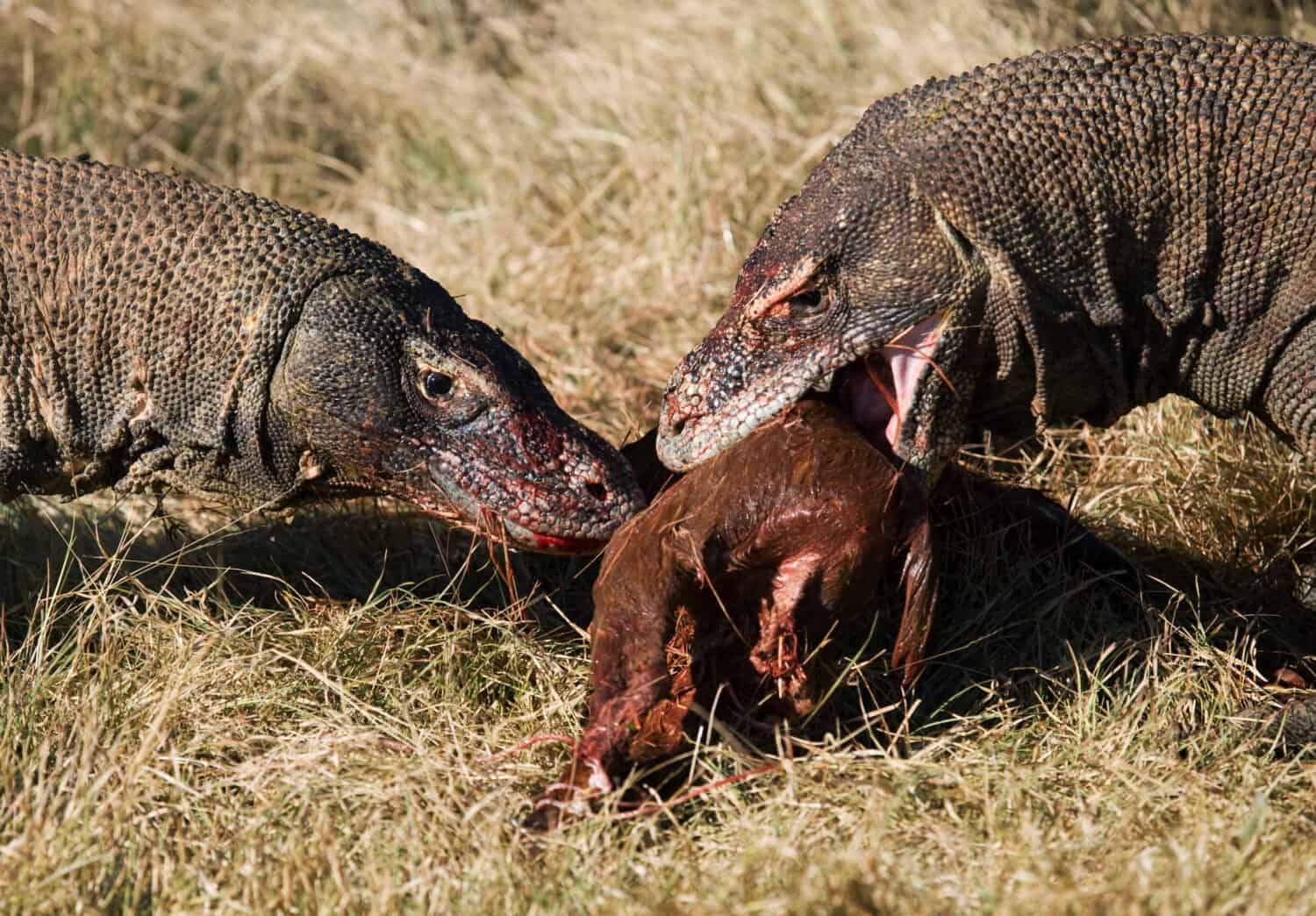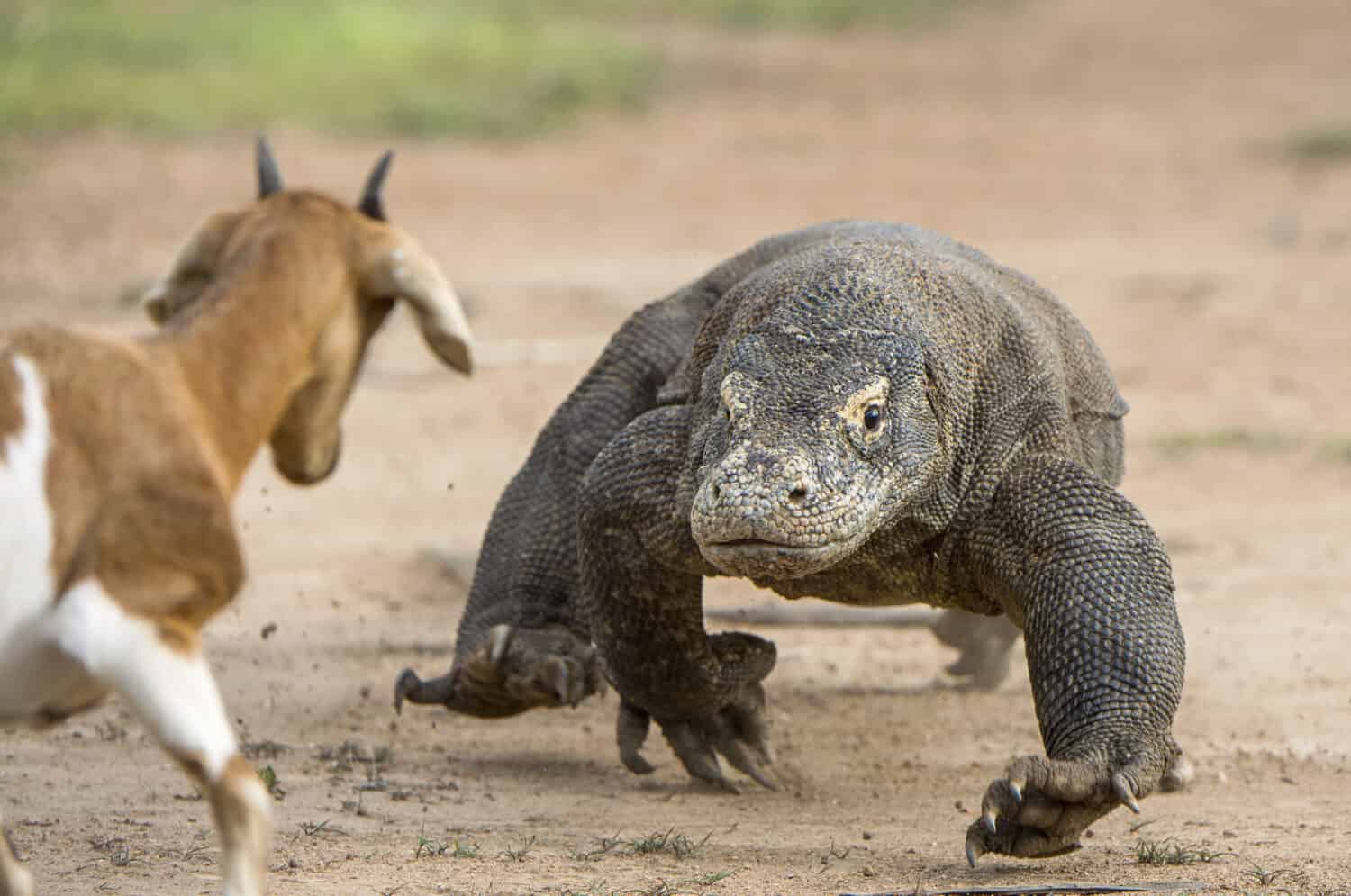Continue reading for our analysis...

In the brutal but vivid video below, we see the Komodo dragon’s raw power and hunting strategy as it captures a monkey. The scene showcases its remarkable striking abilities. With agility and lightning-fast reflexes, the dragon seizes the monkey, clamping its jaws around the neck.
Komodo Dragon Chomps Down on a Monkey, Guess That Settles the Godzilla vs. King Kong Debate!
As the monkey desperately squeals and struggles to break free, we witness the extraordinary strength of the Komodo dragon’s bite, aided by its sharp teeth, inflicting significant damage. These teeth tear through the monkey’s flesh, allowing the dragon’s paralytic venom to take effect. The venom swiftly immobilizes and subdues the prey, ensuring efficient capture.

A Komodo dragon can reach top speeds of 20 km/h when chasing their prey. Here a Komodo dragon swiftly chases down a goat.
©Sergey Uryadnikov/Shutterstock.com
How Does the Seemingly Slow Komodo Dragon Catch Quick Prey?
Komodo dragons, known for their predatory prowess, have adaptations to catch prey swiftly. Their bursts of speed and agility allow them to quickly close the distance to their quarry. Additionally, their keen senses, such as acute eyesight and an exceptional sense of smell, help detect and track prey.
Once within striking range, the Komodo dragon employs a unique hunting technique. It delivers a powerful bite to its victim, causing severe wounds that can prove fatal over time. Furthermore, the dragon’s saliva contains bacteria that induce a slow infection, weakening and incapacitating the prey. This lethal combination of physical trauma and bacterial infection ensures a successful hunt.

The serrated teeth of a Komodo dragon are used to rip into the flesh of its prey, allowing the venom to seep into the victim more easily.
©vladivlad/Shutterstock.com
Despite their size and powerful bite, Komodo dragons are adept at ambushing agile prey, such as goats, wild boar, and small monkeys and primates. Not being able to rely on their speed alone, the Komodo dragon will silently stalk their prey until an attacking opportunity arises. They blend into dense vegetation, patiently waiting for the perfect moment to strike. Their ability to remain motionless allows them to catch their victims by surprise.
It is important to note that the video portrays a dramatic interaction between a Komodo dragon and a monkey, but such encounters are part of the natural order in the wild. The Komodo dragon’s hunting behavior exemplifies the intricate balance of predator-prey relationships. Scientists gain valuable insights into the evolutionary adaptations and ecological roles of these creatures by studying their interactions.
How Do Komodo Dragons Eat Their Huge Prey Whole?

Komodo dragons have extremely flexible jaws and expandable stomachs that can accommodate large meals.
©kiwisoul/ via Getty Images
Komodo dragons have the ability to eat their prey whole due to several factors. First, their anatomy allows for efficient consumption. They have extremely flexible jaws and expandable stomachs that can accommodate large meals. Swallowing prey whole minimizes energy expenditure and ensures they can consume the maximum amount of nutrients. Additionally, Komodo dragons lack a diaphragm, which restricts their ability to chew and swallow in small pieces. Instead, they rely on their sharp teeth to tear off chunks of flesh, but the majority of their prey is ingested whole. In a high-competition environment like the island of Komodo, they also benefit from making sure nobody steals their meal. Once it’s swallowed, it is much harder for a scavenger to steal a Komodo dragon’s food. This feeding behavior is an adaptation that has allowed Komodo dragons to survive and thrive in their natural habitat.
Is it Normal for Komodo Dragons to eat Monkeys?

©USO/ via Getty Images
Komodo dragons are opportunistic feeders and will eat whatever they find. Their menu consists of everything from wild boar and deer to monkeys and goats. These dragons will hunt and ambush their prey then consume their catch by tearing off huge chunks of flesh while swallowing them whole. These reptiles are also known for a few of their hunting techniques. From their impressive jumping abilities, notoriously leaping when they are trying to acquire food or reach prey, to their venom, which prevents blood from clotting. They are also capable of running in short bursts of speed which allows them to catch even quick animals like the monkeys.
Thank you for reading! Have some feedback for us? Contact the AZ Animals editorial team.







